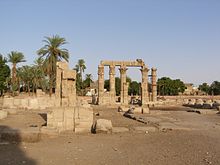Hor-pa-re-pa-chered
| Hor-pa-Re-pa-chered in hieroglyphics | ||||||||||
|---|---|---|---|---|---|---|---|---|---|---|
| Late period |
|
|||||||||
| Great Roman time |
|
|||||||||
Hor-pa-Re-pa-chered Ḥr-p3-Rʿ-p3-ḫrd Horus - Re , the child |
||||||||||
|
Birth of the god Hor-pa-Re-pa-chered in the temple of Armant (back wall of the so-called birth room). |
||||||||||
Hor-pa-Re-pa-chered (also Harpare-pa-chered ) has been documented as a child god in Egyptian mythology since the late period. He represents a subsidiary form of the god Harpare and was worshiped in the Greco-Roman times, especially in the Theban region in the places Medamud , Armant , Karnak , Deir el-Medina and in At-Tod .
Representations
Iconographic representations did not appear in his cult sites until the Greco-Roman period , Edfu was not one of them. On a gate of Medamud the child god is depicted as a standing deity with a hemhem crown , heart amulet and youth curl . The Month gate was built at the end of the first century BC. For the surrounding wall at the end of Sphingenallee . In Armant's Mammisi , Hor-pa-Re-pa-chered in the time of Cleopatra VII and her son Caesarion can be seen as a child god enthroned with a headscarf, youth lock, holding his hand to his mouth, a crook and scourge, optionally with the white crown of the south or perching on a lotus blossom .
The most frequently used motif, however, showed him as a standing god with a hemhem crown, headscarf and youth curl. In addition, Hor-pa-Re-pa-chered could be seen with different crowns, such as the double crown , Geb crown , double feather crown and four-feather crown; also with atef crown on horizontal horns, which was flanked by a cobra sitting on a papyrus plant , a straight feather and a spiral. There was also a winged carab in front of the atef crown .
Mythological connections
With Rat-taui and Month , Hor-pa-Re-pa-chered formed a triad of gods in Medamud. There he was especially venerated as the sun child. His name is attested in several priestly titles. In a ritual scene he can be seen as a fighting deity, how he trampled the nine- arch people and stabbed the Asians.
See also
literature
- Christian Leitz et al .: LGG , Vol. 5: Ḥ - ḫ - Series of publications: Orientalia Lovaniensia analecta; 114 . Peeters, Leuven 2002, ISBN 90-429-1150-6 , p. 271.
- Sandra Sandri: Har-Pa-Chered (Harpokrates): The genesis of an Egyptian god child (Orientalia Lovaniensia analecta 151) . Peeters, Leuven 2006, ISBN 90-429-1761-X .
- Daniela Rutica: Cleopatra's Forgotten Temple. The birth house of Cleopatra VII in Hermonthis. A reconstruction of the decoration (= Göttinger Miscellen. Occasional Studies Vol. 1). Georg-August-Universität Göttingen, Seminar for Egyptology and Coptic Studies, Göttingen 2015, ISBN 978-3-9817438-0-7 .

